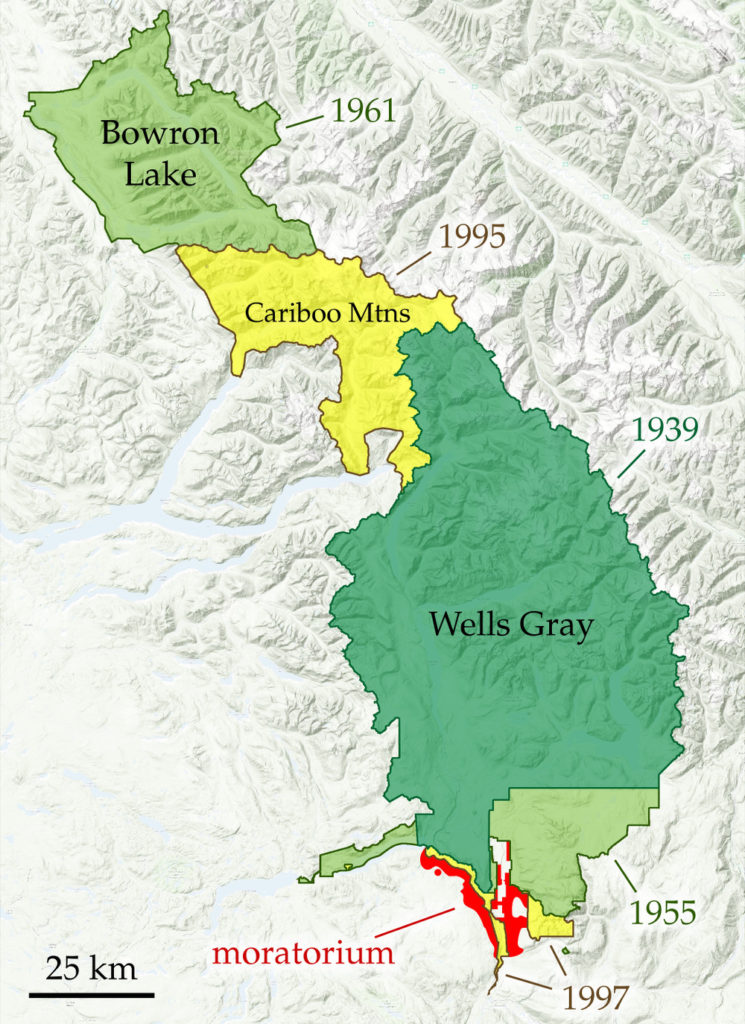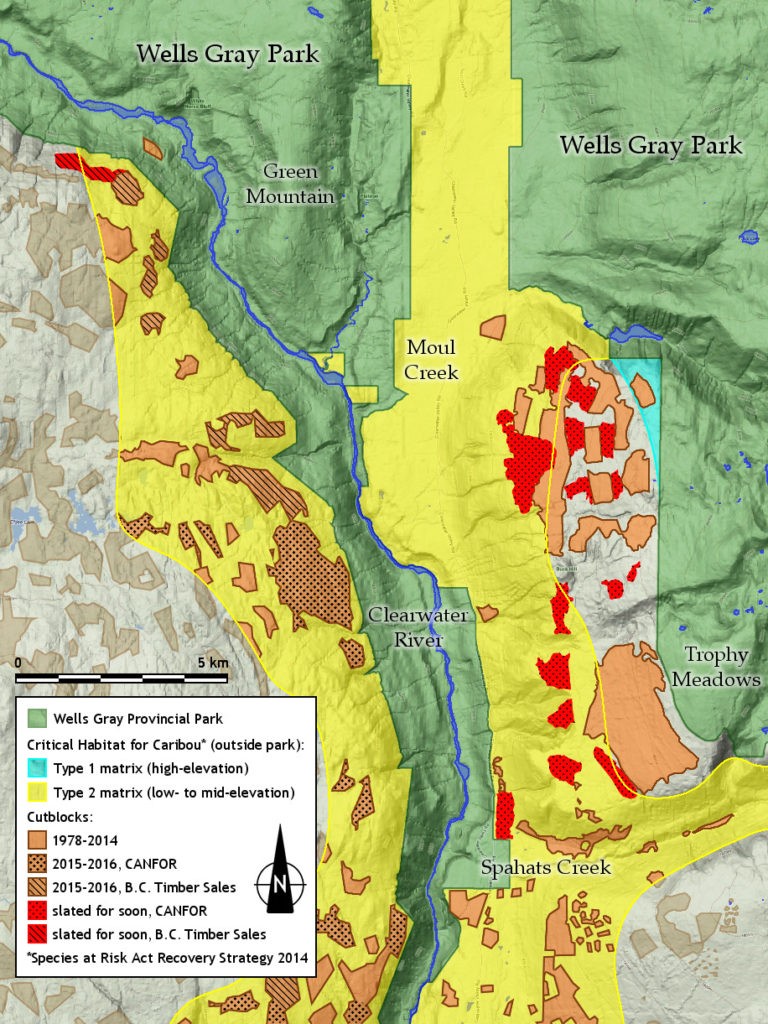The Wells Gray Caribou Connection
Deep-Snow Mountain Caribou need large protected areas in order to survive. Wells Gray Park and adjacent provincial parks provide the only large protected area within their range. In the longer term, these caribou will survive either here or nowhere.
Actually, the decision to establish Wells Gray Park was largely prompted by an episode of Deep-Snow Caribou decline back in the mid 1930s. It is fair to say that Wells Gray exists to give sanctuary to these animals. As proof of this, consider that the sanctuary afforded by Wells Gray has been enlarged on three different occasions since the park’s establishment in 1939: first southward in 1955, then northward in 1995, and then southward again in 1997.
So why does the B.C. New Democrat government under John Horgan insist on undoing the conservation efforts of four previous governments?

The vast protected area formed by the four provincial park shown here came very close to sustaining two or possibly three viable herds of Deep-Snow Mountain Caribou. Taken together, they constitute a major legacy of four BC governments, i.e., the liberal government of Tom Patullo (1933-1941), The Social Credit government of W.A.C. Bennett (1952-1972), the NDP government of Mike Harcourt (1991-1996) and the NDP government of Glen Clark (1996-1999). More recently, the short-sighted policies of BC Liberal governments under Gordon Campbell (2001-2011) and Christy Clark (2011-2017) and the BC NDP government under John Horgan (2017-present) have largely undermined this legacy, raising the likelihood that most or all of these herds will disappear even here, in the the final stronghold for this beleaguered animal.
The Wells Gray Caribou Story
In general terms the plight of the Deep-Snow Mountain Caribou can be attributed to a simple chain of cause and effect. Briefly: (1) intense industrial-scale logging immediately outside the park creates expanses of young sapling forests; (2) young sapling forests attract and provide food for moose and deer; (3) enhanced populations of moose and deer support enhanced populations of bear, cougar and wolves; (4) these enhanced predator populations of sooner or later learn to hunt the park’s Caribou, especially during calving; (5) the park’s Deep-Snow Caribou decline.

It is in the nature of the wolf to prey upon the deer, including the reindeer and, indeed, the Mountain Caribou. But too many clearcuts crowded close to Wells Gray mean too many wolves and, now, too few caribou. Either we learn to accommodate Deep-Snow Caribou by thinking outside the box framed by existing park borders, or else Canada – and the world – will soon lose this icon of Canadian mountain wilderness. No amount of poisoning wolves, sterilizing wolves or gunning wolves down from low-flying aircraft can change that. Partly this is because bears probably kill more caribou in Wells Gray than wolves do. Photo by Mocbuy at wikipedia.
 Intense clearcut logging has been ongoing near southern Wells Gray since the early 70s. Beginning about 1995, the logging triggered a decline in the park’s Deep-Snow Caribou herds which continues to this day. In total the population has dwindled by about two-thirds, that is, from about 325 animals to about 111 animals at recent count.
Intense clearcut logging has been ongoing near southern Wells Gray since the early 70s. Beginning about 1995, the logging triggered a decline in the park’s Deep-Snow Caribou herds which continues to this day. In total the population has dwindled by about two-thirds, that is, from about 325 animals to about 111 animals at recent count.
Extensive logging on the Trophy Mountains during the 1980s appears to be responsible for the disappearance of caribou here in the mid 1990s.
Between the early 70s and 2016, most logging took place outside the Clearwater Valley. More recently, however, MoF has awarded numerous cutting permits adjacent to the park.
 This burst of logging activity within the Clearwater Valley will likely be disastrous for the park’s caribou herds. Briefly, snow in this portion of the valley is light by local standards, so Wells Gray’s deer and moose congregate here in winter – as do its wolves and cougar. Logging this area would create even better winter habitat for these animals, in time bringing even more predation to bear on the park’s caribou. A perfect predator storm.
This burst of logging activity within the Clearwater Valley will likely be disastrous for the park’s caribou herds. Briefly, snow in this portion of the valley is light by local standards, so Wells Gray’s deer and moose congregate here in winter – as do its wolves and cougar. Logging this area would create even better winter habitat for these animals, in time bringing even more predation to bear on the park’s caribou. A perfect predator storm.
What is particularly disturbing about this recent logging is that the forests being cut occur within an area federally designated in 2014 as Critical Habitat for Caribou – a legal designation under Canada’s Species at Risk Act (SARA). For this reason alone, these cutblocks should never have been approved. Yet the government officials who approved them were fully aware of their probable cumulative impacts on Wells Gray’s Mountain Caribou herds.
 There is another reason why stressing southern Wells Gray’s Mountain Caribou is short-sighted. If left alone, these herds would likely soon begin to recover on their own.
There is another reason why stressing southern Wells Gray’s Mountain Caribou is short-sighted. If left alone, these herds would likely soon begin to recover on their own.
Early in the 20th century, wildfire burned off about 90,000 ha of low- and mid-elevation forests here. Nearly a century later, those burned areas support mature forests soon destined to transition to oldgrowth. As this process gets underway, the Clearwater Valley – most of it protected in Wells Gray – will become progressively less productive for moose and hence also for the wolves that predate upon them. With less predation and increased access to oldgrowth at valley-elevations, the park’s caribou herds are expected to rebuild. Indeed, nowhere else within the range of the southern Mountain Caribou does the future look so bright. Or so it would if logging near the park hadn’t triggered the loss of half the herd in the past decade alone.
The writing is on the wall. Deep-Snow Mountain Caribou need oldgrowth forests. The vast protected area encompassed by Wells Gray Park northward to Bowron Lakes are destined to become one of two or possibly three final sanctuaries for Canada’s knobbly-kneed “Grey Ghost.”
The hour is late for the Deep-Snow Mountain Caribou, but perhaps not yet too late. Caribou Hope.
